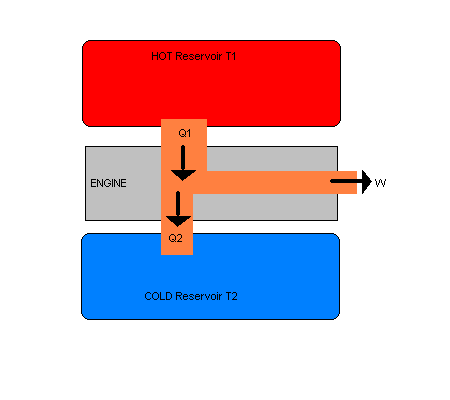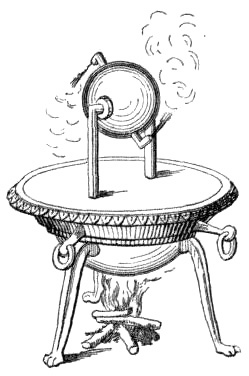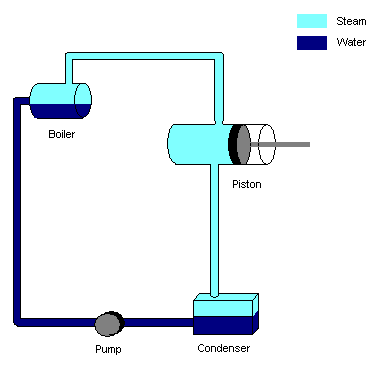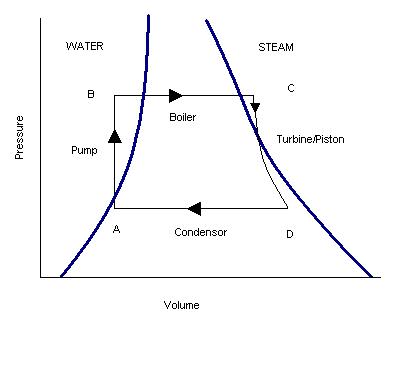
Heat Engines
A heat engine is any device that can convert heat energy it receives and turn it into usable work. According to the second law of thermodynamics no heat engine can be a hundred percent efficient due to the requirement that entropy always has to increase. Because of this a heat engine must dispose of some of the thermal energy it receives as waste heat.
In order to simplify the way the way a heat engine work lets take a look at a theoretical engine and ignore all the mechanical parts of the engine.

The key to this engine is that it takes in heat from a hot reservoir and expels heat to a cold reservoir. A reservoir is an idealized heat source or sink that doesn't change in temperature no matter how much heat is added or removed. Of course a real heat source or sink does always stay the same temperature but this is the first approximation that we will make for the engine.
How a Engine Works
The hot reservoir has a temperature of T1 and the cold reservoir has a temperature of T2, T1 >> T2. Heat enters the engine from the hot reservoir, in order to get this to occur the engine has to be at a lower temperature than the hot reservoir (2nd Law: Heat flows for a high temperature to a low temperature). Once the heat is inside the engine it can be manipulated using different types of expansion (see the compression section). The excess heat that cannot be used by the engine is dumped into the cold reservoir. In order to get that heat to actually flow out the temperature of the engine at the time of expelling heat must be just above T2. This means that the engine must work between the temperatures of the two reservoirs never getting hotter than the hot reservoir and never cooler than the cold reservoir.
That is it for a basic engine! Now the more interesting things tend to occur when we begin discussing the actual cycles that engines use.
The Steam Engine (Rankine Cycle)
Normally when we think about the steam engine we think of the old trains that are no longer in use today. Actually the first steam powered device was developed in about 1 AD by the Hero of Alexandria. This steam powered “engine” was actually more of a toy than anything else. The idea was that water is heated in a round container, the container however had a pipe on each side that would allow the steam to escape. The pipe were oriented in such a way that the engine would begin to spin as the steam exited.

You may wonder now why I am introducing you to the steam engine when it is such an old device. The truth is that the steam engine although introduced a great deal of time ago is still in use today. Actually the majority of the power we use today comes from a modified version of the Rankine cycle steam engine. Power plants that burn fossil fuels and preform nuclear reactions use the steam engine to capture the thermal energy released and use it to preform work (in this case drive a generator and make electricity).
The Rankine Cycle
Use the following diagrams along with the explanation of the Rankine cycle.


A-B > Water is pumped to high pressure and no heat is lost
B-C > The water us then heated at a constant pressure. Eventually the water will under go a phase change and become a saturated gas.
C-D > The steam then strikes a piston or a turbine and expands. This expansion is adiabatic so the temperature of the steam decreases and returns to the water state.
D-A > The final step is a condenser which removes the heat from the engine. The condenser is required along with the pump to insure a pressure difference at both ends of the engine. Without them it would take as much work to move the piston on a power stroke as would be needed to be added to exhaust the steam.